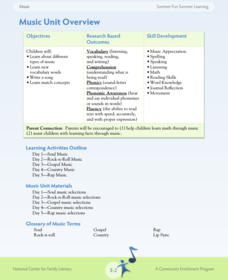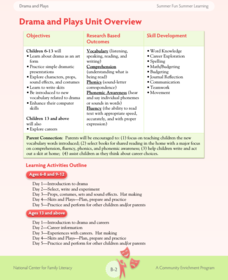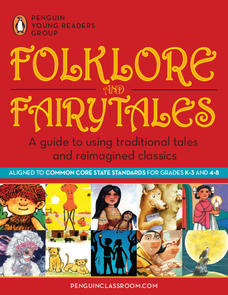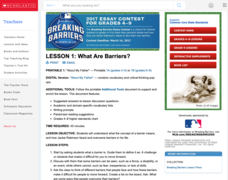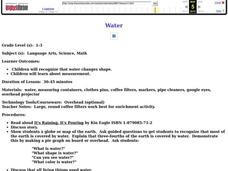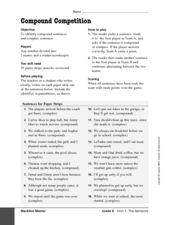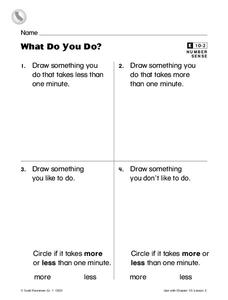Curated OER
Gingerbread Baby v. Gingerbread Boy #7
Students read two stories. In this comparison lesson, students read "The Gingerbread Baby," by Jan Brett and the original "Gingerbread Boy." Students use a Venn Diagram to compare and contrast the two stories.
National Center for Families Learning
The Summer Fun Summer Learning Music Unit
Take note. Soul music. Gospel music. Country music. Summer comes alive with the sounds of music as program participants learn about various genres of music, create instruments, and write and perform songs about the facts and traditions...
National Center for Families Learning
The Summer Fun Summer Learning Drama and Plays Unit
The play's the thing that puts the play in a summer learning drama program designed to combat summer slide and encourage family literacy. Participants learn about drama as an art form, engage in dramatic presentations, write scripts, and...
Penguin Books
Folklore and Fairytales: A Guide to Using Traditional Tales and Reimagined Classics
Every culture has its own stories to tell. An interesting educator's guide shares a large collection of fairytales and folktales, some from different cultures and some re-creations of classics. A summary and brief teaching ideas...
Reed Novel Studies
Hatchet: Novel Study
Thanks to Gary Paulsen's Hatchet, teen readers now know it's possible to survive in the wilderness. A study guide for the novel discusses common topics and vocabulary words found within the text. Additionally, readers get the chance...
Spelling City
Card Flip Game: Synonyms and Antonyms
Match words to their synonyms and antonyms with a card flip game. Kids turn over two cards on their turn and determine if they are synonyms or antonyms; if not, they replace the cards and try again.
Scholastic
Lesson 1: What Are Barriers?
Scholars discuss the concept of a barrier with a short passage on Jackie Robinson. The writing process begins with a paragraph and several other sentences about Robinson's unique traits that made breaking a barrier...
Curated OER
Thanksgving Poem
First graders read a Thanksgiving poem to build reading comprehension skills. They develop the skill of using context clues while explaining the meaning of each line of the poem. The assessment is done as the teacher listens to poems...
Curated OER
Water
Students complete activities to examine the properties of water. In this water science lesson, students read a book about water's forms and study a map or globe of the Earth to investigate water. Students discuss living things that need...
Curated OER
The 3 Little Pigs
Second graders create new endings to The Three Little Pigs. They read and discuss The True Story of the Three Little Pigs and compare it to the original version. After comparing the two versions, they write a friendly letter to the wolf...
Curated OER
Weather "Why"
Students research weather and explore how to use their research information. In this weather information lesson, students visit a given website for weather forecasts. Students graph the weather, sing weather songs and select a class...
Curated OER
Figurative Language
Twelfth graders examine personification and alliteration in various reading selections. They read magazine articles, brochures, and advertisements, identify the examples of personification and alliteration, and create a business name...
Curated OER
I Can See You
Second graders explore living without sight. In this senses lesson, 2nd graders review the different senses and what they use for each sense. Students discuss what it would be like to not be able to see and they read a story about a...
Curated OER
Discovering the Journal of Augustus Pelletier
Students explore journals. In this Discovering the Journal of Augustus Pelletier lesson, students read the historical fiction book and conduct research activities to validate events in the plot that reflect the Lewis and Clark...
Curated OER
Dinosaur Days
Students investigate the age of dinosaurs while examining the characteristics of three kinds of dinosaurs. They examine plant eaters, meat eaters, and flying dinosaurs while determining how to classify things. They rotate through centers...
Curated OER
What We Need
First graders identify basic needs of plants. In this plant growth lesson, 1st graders observe types of plants and review the parts of a plant as well as the development of a seed. Students review related vocabulary and read The...
Curated OER
Yummy for my tummy!
First graders read the story Tops and Bottoms and identify vegetables that are eaten from the stem, root, and leaf of a plant. In this vegetables lesson plan, 1st graders learn vocabulary about different vegetable parts and write journal...
Curated OER
Now That I've Been Analyzed, What's Next?
Students examine their personal health. In this health lesson, students complete a scavenger hunt based on their BioImpedance (BIA) readings and then write a personal analysis.
Curated OER
Magnificent Mythology
Sixth graders research Greek mythology and explore mythological references. In this Greek mythology lesson, 6th graders view a PowerPoint about Greek mythology and read myths and their characteristics. Students discuss the relevancy of...
Curated OER
Families of Mount Olympus
Sixth graders explore Greek mythology. In this Greek mythology lesson, 6th graders research selected Internet sources on Greek gods and goddesses. Student use their research findings to create mythology family tress. Students also read...
Curated OER
Guess What I Came From
First graders examine items made from plants. In this plant lesson plan, 1st graders read Plants Feed on Sunlight and view a PowerPoint presentation regarding plant growth. Students examine products that are made from plants and draw...
Curated OER
I Know Why the Caged Bird Sings: Chapters 34, 35
Students analyze Maya Angelou's I Know Why the Caged Bird Sings in part of an analysis of imagery. In this Maya Angelou lesson, students read chapters 34 and 35 in the novel and define imager. Students work in pairs to locate two...
Curated OER
Compound Competition
In this compound sentences worksheet, 6th graders identify sentences (18 are given) as compound or complex by working in teams, answers included.
Curated OER
What Do You Do?
In this elapsed time worksheet, students read 4 problems in which students draw an activity that takes a specified time. Students also estimate how long activities would take.

